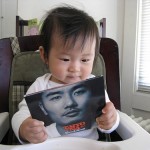Perhaps it sounds obvious, but engagement with APIA art and writing shouldn’t be limited to the Month of May: APIA writers and artists are, of course, producing and performing and publishing new and challenging works all year round. Here are a few recommendations to get you started for the summer (in no particular order):
1. Takeo Rivera’s GOLIATH (dir. Alex Mallory). This powerful one-act choreopoem about the implications of the Iraq War, which began life as an original student play at Stanford, is making its New York City debut tomorrow, thanks to the brilliant creative talents of its playwright (Takeo Rivera) and its director (Alex Mallory). Takeo is one of those rising-star-types whose work is impossible to miss once it’s entered your periphery: his aesthetic roots lie in the brave activism and the rhythmically-compelling sonic and dramatic gestures of spoken word, and his critical approach to his subject matter is thoughtful, complex, and blade-sharp (he has a Masters Degree in Modern Thought & Literature and is about to enter a PhD in performance studies this fall). Alex (GOLIATH’s director), is also a forced to be reckoned with: she’s been directing productions and workshops in New York for a couple of years now, and before that, in college, she honed her chops by directing a number of major student productions and by founding The Stanford Theatre Activist Mobilization Project. Alex was also the major force behind bringing GOLIATH to the Big Apple. GOLIATH has been newly revised for the New York stage and will be playing at the Robert Moss Theater for the next two weeks. If you’re living in New York City or will be in its vicinity during the next few weeks, I urge you to see this play. I t’s not something you want to miss! [See the teaser trailer above].
2. “We Axe You to Speak”: Kartika Review’s first poetry reading. Yes, folks. Kartika Review’s inaugural reading event is tonight (6 to 8 pm at the SF Public Library, 100 Larkin St), and I highly recommend it (though I’m sad that I’ll have to miss it because I’m not on the West Coast). Barbara Jane Reyes, Eddy Zheng, Margaret Rhee, Shelley Wong, and Kenji C. Liu. Great lineup. Landmark event. To those of you in the Bay Area: GO. You do not want to miss this if you can help it.
3. “I Got My” Music Video ft. Jin [Magnetic North and Taiyo Na]. Bao Phi posted on Facebook that this “is not a music video – more like an Asian American family reunion, or maybe a map. Whatever it is, it’s a gift.” One can’t help but agree: so many landmark APIA faces! The video was created for APIA month, but its awesomeness, of course, extends far beyond the month of May alone. Here’s the video:
Continue reading “Editors’ Picks: APIA Writing Doesn’t End with May.”






